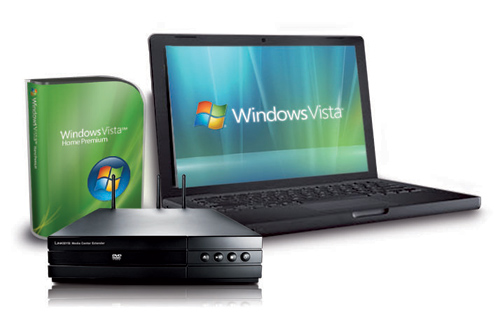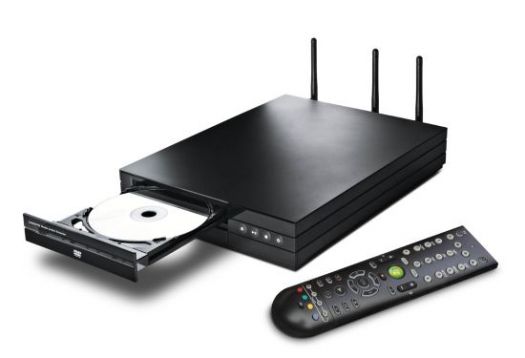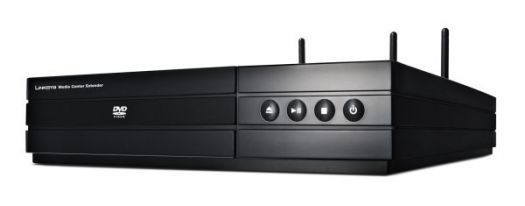With our recent review of the D-Link DSM-750 "MediaLounge," we explored the virtues of bringing the Windows Media Center experience, Microsoft's PC-based multimedia access/control hub, from any room in the house to the home theater. Such a device is called a Media Center Extender, a dedicated box that accesses PC- or network-based audio, video and photos from a small discrete box that connects easily to your television or audio/video receiver. The MCE itself mirrors the big, clear "ten-foot user interface" of the Media Center PC application, with scads of audio/video connections and a familiar remote control.
Media Center Extender boxes work with either a wired or wireless connection to a home network. As we are on the verge of 802.11n technology--the newest wi-fi gear actually works off a draft of the N specification--the previously impossible speed, range, and reliability now enable easy do-it-yourself installation anywhere in the house. What we gain is entrée to all of the music, photos and video on the host PC, including ongoing NTSC/ATSC recordings made to the hard drive via a DVR, if we have a TV tuner installed. Think of almost anything that a well-equipped multimedia computer can do, now consider bringing it to the home theater.
One thing that no Media Center Extender can do is stream DVD playback from one location to another. For those who want DVD functionality in their extender device, or are simply looking to reduce clutter by combining two components in one, Linksys offers their DMA2200, a Media Center Extender with an integrated DVD player. Moreover, the player offers upconversion of standard DVDs to higher, HDTV-friendly resolutions (720p, 1080i, 1080p) over its HDMI output.

Little Face, Big Butt
The unit itself is an unusual design for the home theater, deeper than it is wide, with a main power switch around back in addition to the front panel button, like a computer or videogame console. The DMA2200 requires about 15 seconds to boot/reboot, and even restarting a disc after we press Stop requires another 10-15 seconds recovery time. There are three wi-fi antennae on the rear panel, but they are adjustable and should pose no problem if we want to stack other gear on top, which is tricky only because of those unorthodox proportions again. The box does become warm, no doubt owing to all of the PC-caliber processing taking place inside, but is fan-cooled, inaudible unless you are a few inches away and all other gear is turned off.
Initial setup was complicated by the fact that, out of the box, the DMA2200 did not recognize its own HDMI port, and so I had to run a quick-and-dirty composite video/analog mono connection in order to configure the settings. As I suspected, a simple firmware upgrade was all it required, but I made the mistake of contacting Linksys customer service, who shared the professional opinion that the unit was physically broken and needed to be replaced. (Again, it wasn't, and it didn't.) The great thing about this being a networked CE product is that it always has the internet just a click away, and maintenance like firmware tweaks are quick and simple via the hardware Settings menu.
As is standard practice with Extenders, the DMA2200 generates an eight-digit code which we walk over to the PC and enter to authorize the device. A few more clicks via the WMC interface, a minor glitch (the wireless connection was lost for reasons I don't understand) and voila, I had Media Center on my TV. Over HDMI, the interface is razor sharp, and video is what it is: The limited variety of available HD content looks great, compressed stored video or streaming files don't. Sonically, the hardware does nifty tricks like internal Windows Media Audio Pro 5.1-channel decoding, should a connected receiver not support this esoteric codec.
Where No Extender Has Extended Before
With a multitude of Windows Media Center Extenders on the market, clearly the big selling point of the DMA2200 is its upconverting DVD player, so I eagerly loaded up my copy of our reference DVD, the HQV Silicon Optix Benchmark, Version 1.4 NTSC. Inasmuch as I was testing the source component's ability to upconvert the signal, not the display's, I made sure that the player was set to its maximum 1080p resolution over HDMI output to my Samsung HL-T5087S DLP.
Video performance started out with a whimper unfortunately, as the Color Bars revealed a smooth transition from dark to light blue but also a wild flashing of the two vertical black and white bars at area 1 of the pattern, denoting half, not full resolution. Only when the large rotating bar in "Jaggies" Test Pattern 1 was practically straight up and down did it show a smooth edge, and at the red, yellow and green portions of the dial it exhibited a variety of stair-stepped edges from noticeable to highly distracting. At no point in the little three-bar shuffle of "Jaggies" Test Pattern 2 were any of the moving bars acceptably clean, and the bottom one in particular wiggled like something out of a bad acid flashback.

I'm grateful for the DMA2200's rendition of the American Flag only because I now have a memorable frame of reference for what this test is not supposed to look like, with digitized notches across every stripe, almost non-stop. The bricks behind the flag were washed out, and although artifacting on the windows is not officially part of the test, I've never seen this problem so pronounced before.
The gold statue on the left side of the frame was the best aspect of the Picture Detail test, but even that appeared unnatural, lacking the necessary nuance around the edges and across its surface. The grass looked soft, which would be fine if I wanted to throw down a blanket and have a picnic, but more individual blades should have been discernible. Again, not a part of the test, but the stairs below the statue hardly even looked like stairs, they were so vague.
The Noise Reduction nature scenes were hindered by flickering skies ranging from fair to bad to very bad, with mosquito noise evident around finer points, too. In Motion-Adaptive Noise Reduction, I observed an extremely noisy sky above and around the roller coaster, while the coaster itself was blurry and lacking any real detail. The scene of the boat chugging under the little footbridge was noisy just about everywhere except on the green leaves over the rail in the foreground.
The Super Speedway Film Detail test is cut-and-dry: Severe, unmistakable moiré plagued the stands every second, suggesting that the player has no inherent detection or processing for 3:2 film cadence material, which makes up the bulk of what's available on DVD. The battery of Film Cadence demos exposed quivering rims on the telltale coffee cups and jagged stair-step edges on the newspaper in every format, with only minor differences between each. (The 8-7 Anime cadence was among the least offensive). Exams ended with a bang however: Mixed 3:2 Film with Video Titles were perfectly steady in both the horizontal and vertical video crawls. Unfortunately this is something most often seen on live broadcast TV shows, not on pre-recorded DVDs.
Back to the Future
I know how good Blade Runner: The Final Cut can look on my Samsung HL-T5087S 50-inch DLP, and so I wondered if the DMA2200 could upconvert this go-to 480p DVD to a level of quality approaching 1080p Blu-ray. Could it essentially replicate (that's a Blade Runner joke) a high-def experience? The short answer is "Well, no, it can't," as the softly gradated skies of Los Angeles, 2019 and smoky interiors suffered from a substantial amount of noise. The spires of the skyline also often looked like gelatinous black vertical streaks. For comparison, I played the same scenes on my PlayStation 3, which fared slightly better, but again there was no mistaking this for anything but DVD.

I was then pleasantly surprised how crisply and colorfully it rendered the digital animation of Toy Story. The only significant problem here was noise in soft-focus moving backgrounds, but those instances were virtually identical on both the PS3 and the DMA2200.
Turn-Ons
Turn-Offs
Final Thoughts
As a Media Center Extender, the Linksys DMA2200 does what it is supposed to do - it extends media playback from your PC or laptop directly to your electronic hearth - the home theater system or HDTV. This can be a boon for those who store large quantities of photos, music and/or video on a PC or home network and wish to access these assets from the convenience of the living room or home theater environment.
The idea of combining a well-featured DVD player with a Media Center Extender is enough convergence for me, did Linksys also have to position it as an upconverter? The picture quality is acceptable at 480p output, but you could have fooled me that any enhancement was taking place at the higher settings. Clearly though, if you want the convenience of Media Center and DVD together, this is a fun, useful product.
Where to Buy:
Package Contents:
Outputs:
Input:
PC requirements for Media Center Extender Mode:
Supported Media Formats:
Audio:
Video:
Photos:
Optical Discs:
Network:
Wi-Fi:
(2.4GHz and 5GHz bands)
Wired:
MSRP: $349.99
Weight and Dimensions:
Warranty:
Company Information:
Linksys
121 Theory Drive
Irvine, CA 92617
ph: 800-LINKSYS
Web site: www.linksys.com/
| Overall | |
|---|---|
| Value | |
| Performance | |
| Features/Ergonomics |